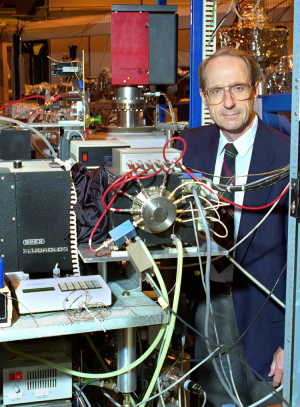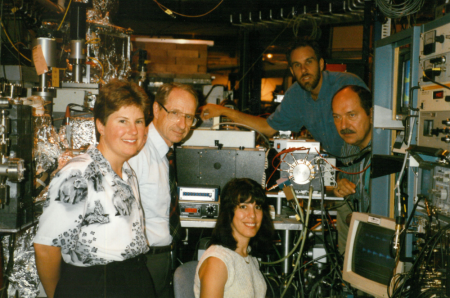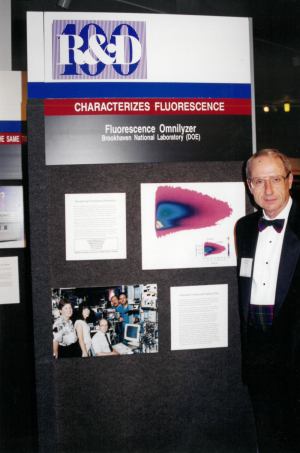The Fluorescence Omnilyzer is a device that detects visible, ultraviolet, and near-infrared light and can be used as a detector for fluorescence techniques. Developed by John with others, the Fluorescence Omnilyzer won an R&D 100 Award in 1997.
The detector takes advantage of the pulsed vacuum UV light from John’s synchrotron beamline U9B, says Lisa A. Kelly, who was then a postdoctoral fellow working with John. “With pulses of light, you can do time-resolved fluorescence spectroscopy,” says Kelly, now an associate professor of chemistry and biochemistry at the University of Maryland, Baltimore County. That capability would enable dynamic investigations of excited states that are involved in biological processes.
“The instrument sees everything from one signal,” Kelly says. “Otherwise you’d have to repeat the experiment three times with three instruments.” The data, Kelly adds, give information about the excited state of the molecule and what reactions it can undergo.
The Fluorescence Omnilyzer is a device that detects visible, ultraviolet, and near-infrared light and can be used as a detector for fluorescence techniques. Developed by John with others, the Fluorescence Omnilyzer won an R&D 100 Award in 1997.
This detector can record the wavelength and linear polarization of each detected photon and the time delay between excitation and emission, which is about everything about fluorescence that you want to know. So I called it the Fluorescence Omnilyzer.
The detector takes advantage of the pulsed vacuum UV light from John’s synchrotron beamline U9B, says Lisa A. Kelly, who was then a postdoctoral fellow working with John. “With pulses of light, you can do time-resolved fluorescence spectroscopy,” says Kelly, now an associate professor of chemistry and biochemistry at the University of Maryland, Baltimore County. That capability would enable dynamic investigations of excited states that are involved in biological processes.
“The instrument sees everything from one signal,” Kelly says. “Otherwise you’d have to repeat the experiment three times with three instruments.” The data, Kelly adds, give information about the excited state of the molecule and what reactions it can undergo.
John loves to teach; he loves to explain things. He was a wonderful mentor. He did everything a mentor could do to help me get ready for the next stage of my career. He gave me confidence to go forward at a scary time. John as scientist, educator, and mentor – in all roles, he does very well.
PUBLICATIONS



